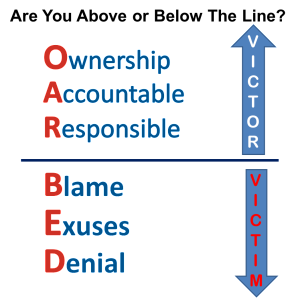Oct 1, 2015 | Self, Team
When things don’t go as planned in your business; schedules missed, customer’s expectations not met, quality of work not up to standards; what do you hear? Blame, excuses, denial? Or ownership of the issue, accountability for the results and responsibility for taking corrective action? If you’re like most business owners, you hear lots of reasons and excuses. How did this culture develop in your company? How did your team come to accept this behavior as the norm in your business?
Look no further than the mirror. It starts with you. Even if you are not the one making excuses, your team has witnessed you enough times accepting blame and excuses. Or visibly punishing mistakes that are not soon forgotten. People learn the acceptable excuses for explaining why they did not achieve their goals. Rewards for exceptional performance barely exceed rewards for the ordinary. And people hide the truth – to be polite and safe – and in denial.
Why is Accountability important?
It closes the gap between intention and action. Between plans and results. Between goals and success. And its the foundation of an ethical business culture. If you focus on or change nothing else but accountability in your business, you will see massive results.
Accountability and empowerment are inseparable. When someone is blaming and making excuses, they see the cause and solution as being outside of themselves. Outside of their control, influence and power. They have no capability or power to change the outcome. Accountability is a promise and an obligation, both personally and to the people around you, to deliver specific, defined results.

Accountable people are aware of the positive and negative consequences of their actions – they want different consequences – they take different actions. A team organized for accountability, to achieve a desired result, immediately becomes interdependent. In order to achieve effective interdependence, you must have the structure to support it in place. Accountability in your business requires structure, focus and clarity that supports and builds trusted relationships and gets results.
Where to Start – Key Principals of Accountability
- A personal promise – that you agree to
- Results means activities are not enough – you do whatever it takes to achieve results
- Results requires room for judgment and decision-making – empowerment to use discretion
- Neither shared nor conditional – you are responsible for your commitments – not shared with another and it is unconditional regardless of limited control, other’s mistakes, or a lack of role clarity.
As soon as you hear yourself saying “ . . . because . . “ STOP, rethink what you’re about to say. Rephrase it until you are clearly taking full responsibility, describing a situation where YOU have control to do something different. Start with you. It will not go unnoticed by your team.
May 5, 2015 | Leadership, Self, Team
 5 Ways to Improve Your Communication Skills
5 Ways to Improve Your Communication Skills
Effective communication is key to your development and progress, not to mention that of your team! Without effective communication, you will lag behind in many aspects of your personal and professional life. And your team, therefore your business, will not reach its full potential without the tools to communicate effectively.
If you want to improve your communication skills for clarity and effectiveness, here are some vital tips for you to follow:
1. Listen Carefully
Let’s admit it, we all struggle with this. First seek to understand what the other person is saying and feeling. If you find that you are formulating a response while the other person is talking, you are NOT listening. You have to shut off that voice in order to listen. Pay attention, be patient with them and do not interrupt. Not only is it rude to cut someone off, but it makes it hard to understand what they are saying. Wait for them to finish before you even think about your feedback.
2. Body Language
Often, we don’t realize the significance of our body language, but it can account for 70% of what we communicate. After all, actions speak louder than words. Your facial expressions, eye contact and gestures reveal everything, even though you do not utter a single word.
Exercise to improve your posture. Stand straight and smile to stimulate positive feelings. Always maintain eye contact when talking to someone. Use open body gestures. Watch your facial expressions and the tone of your voice. At the same time, educate yourself about different non-verbal communication signals in different countries, cultures and societies. For example, the handshake is considered rude in some countries, whereas is it a common practice in the US.
3. Read and Write
In order to improve your verbal communication, read and write as much as you can. Read books, newspaper articles, blogs or anything of interest to boost your vocabulary and write a blog to improve your writing skills. Similarly, watching some programs related to your areas of interest and movies can also help improve one’s communication skills.
4. Ask Questions
Asking questions helps clarifying things. It shows that you are truly interested in having a conversation and understanding the other person. Moreover, it also helps overcome the fear of small talk. Learn to ask good questions, it will improve your ability to engage your audience.
5. Manage Stress
Stress can be a major impediment to effective communication. Learn to manage it. Don’t communicate with someone if your stress level will make you sound irritated or angry with them. Use humor in your conversations, keep calm, exercise and drink lots of water.
The ability to communicate clearly, concisely and coherently takes years of practice. Hence, incorporate the above mentioned steps to not just improve your communication skills, but also improve the quality of your life.
To learn more, get in touch or come to ActionClub!
Apr 21, 2015 | Leadership, Self, Team

Are You Leading Or Managing Your Company?
As the owner or chief executive in your company, how much time do you spend on leading and not just managing? If your goal is to create a growing, profitable business that can work without you, strong leadership is a must.
Author William Arthur Ward once wrote, “Flatter me, and I may not believe you. Criticize me, and I many not like you. Ignore me, and I may not forgive you. Encourage me, and I may not forget you.” Leaders come in all shapes, sizes and from all ways of life, but they do have common characteristics.
- They create a vision and understand that true change is driven by emotion, not logic. In other words, they transform the mundane into a passion that their team can rally around. What benefit do you create for your customers? Don’t think you have one? Here are some examples: bankers and financial planners make dreams come true, communications companies educate and inspire, consultants and recruiters create a livelihood for workers, photographers preserve memories. What noble cause does your company provide?
- Leaders know how to link vision and action. It’s not just about a vision; it’s about making that vision come alive. They have a unique way of separating the important from the interesting and then focusing on one of those things.
- Leaders create an environment of accountability. Not only do great leaders demand accountability of themselves, they demand it of their team. Excuses are not allowed.
- Leaders have a strong character and aren’t swayed by what’s easy or popular. When faced with a challenge, they do what is right, not what is easy.
- You are not a leader unless you are willing to make the tough decision.Sure it is easier to say “yes”, than “no”. Charles Nielsen once said, “When, against one’s will, one is pressured into making a hurried decision, the best answer is always ‘No,’ because ‘No’ is more easily changed to ‘Yes’ than ‘Yes’ is changed to ‘No’.” As a leader, it is more important to make the right decision than the easy decision.
- Leaders inspire through their everyday actions and words.You don’t need long speeches or memos to inspire. Lincoln’s, “Gettysburg Address” was less than three minutes long and Churchill’s famous, “Blood, Sweat and Tears” speech was two and a half minutes long. Words are important, but actions inspire even more. Mother Teresa’s credo was, “Let no one come to you without leaving better and happier.”
- Leaders realize that no one, including himself or herself, is indispensable. Once you become bigger than the cause, you cease to lead. Translated into business, teach your team to do things better than you ever could and you will both benefit.
Leadership doesn’t happen overnight, but a mentor, like me, can help you understand how to take the first steps and then work with you as you transform your management skills into leadership skills.
Practice your leadership skills! This will benefit you, your family, your team and your customers.
To learn more, come to the next GrowthClub!
Nov 3, 2014 | Team

How do you find the right team? Too often I hear business owners say ‘I can’t get good people’ or ‘why can’t I get my people to do as I tell them’. Well here are a few ideas that may make life a lot easier.
Consider for a moment, the business owner who has 10 people working in the business, yet the owner is doing all the work. What’s the point?
First, get the basics in place. Most people in business understand how important systems are to running a business smoothly (and profitably). With systems and processes in place, it’s simply a matter of employing people to run those systems. Michael Gerber’s book, The E-Myth, highlights how critically important systems are for business success. One of the best examples of course is McDonalds. With a food product that at best could only be described as average, McDonald’s systems make it a highly successful entity.
The point is, if you feel like you’re banging your head against a wall, take a look at the systems in your business. Look at the most basic things from answering the phone all the way through to how you produce your product or service. If your systems aren’t clearly defined, documented and easy to understand, how can you deliver consistently to your customers? To create the best systems, write them down, or capture them in videos or photos, or turn them into checklists. Systems and processes are the basic foundation of business — and are critical to getting your people to work as a team.
With the systems built and clearly defined, now it’s a matter of recruiting the right people to run those systems. The DISC working personality profile can help in selecting the right people for the job, and crafting job descriptions and ads that will attract the right people. With this knowledge and a formal recruiting process, you can then recruit the right people for the job. However, it’s not just a matter of having people who come in, follow the system and get the job done. What you are looking for now is SYNERGY!
Synergy comes from a team commitment to a ‘common goal’. If you involve your people in setting the ‘common goal’, they are generally more likely to take ownership and give you their best. If you, as the business owner are dictating the goals to your team, don’t expect much commitment. If your team has ownership, they are much more likely to achieve the goals.
Keep asking your team this question…’I’m looking for [certain outcome], how do you think we should go about achieving that?’ The successful business owner has team members that say ‘I think we should do this’. An unsuccessful business owner has team members that say ‘I don’t know, you’re the boss’.
Finally, be aware of what you are teaching your team. For example, if every time they come to you with a problem, you just give them the answer, guess what they learn? They don’t have to think, you will do all of that, and if the solution doesn’t work, it’s your fault. Instead of giving them the answer, ask them what their solution is? Guide them through the decision-making process so they learn how you think through problems. After a while they’ll stop coming to you, and will be fully invested in their solutions, which means they’ll be much more likely to make sure the solutions work.
Try building a team that works with you and the culture of the company. The more cohesive the employee relationships are the more you will get out of your team. Try these few things out and see what a difference it has on your bottom line.
Feel free to get in touch with me for more help with finding and motivating the right people for your team.
Oct 13, 2014 | Marketing, Self, Team, Time Management

Here are 5 business mistakes to avoid (now more than ever):
1. Ignore your customers. If you neglect your customers, someone else will be happy to take them. Did you know that 68% of customers leave due to perceived indifference – they think you don’t care!
Instead of focusing all your efforts chasing new ones, cut yourself a great deal and focus on keeping your existing clients. Its 6 times more expensive to get a new client than it is to keep the one you have now. By the way, have you graded your customers A – D? Focus on A & B, convert C’s, and let the D’s go!
The general rule is to keep some kind of contact at least every 90 days. That could be a call, visit, card, or email, or even try JibJab. You are only limited by your imagination.
2. Stop advertising, marketing, promoting. Avoid the knee-jerk panic reaction to stop promoting your business. It just accelerates the downward spiral. Remember, real marketing starts long before the sale and continues long after.
You don’t have to spend a lot of money. You just have to be selective and track your results.
Contact me and I will be glad to share inexpensive ways to get noticed. By the way, any advertising you do should include a “call to action”. Forget image, ring the cash register! Focus on your target, communicate a compelling offer, and drive the sale!
3. Neglect your team. Now more than ever, the team has to “hit on all cylinders”. You need to have less tolerance for under-performance and waste. There are a lot of great people looking for jobs. One advantage of economic downturns is the opportunity to select some strong talent.
As the leader, you must strike a careful balance, encouraging and motivating the team while sharing feedback and holding them accountable. Don’t forget training and development either. Your team is one of your greatest assets; invest in them now to pay dividends in the future.
4. Waste your time. Your only non-renewable resource is your time. You can always make more money, but you can never create more time. Once today is gone, it is gone forever. Ask yourself: What is the best use of my time for the business right now? Ask that every day, especially as you plan the next one.
By the way, the best time to plan tomorrow is at the end of today. Another suggestion: Turn off automatic downloading and notification of email. The time you save each day from that distraction will startle you. One more thing: When was the last time you updated your default calendar? Take control – do it today!
5. Make excuses for doing any of the above. Who are you kidding? If you are guilty of succumbing to the temptations above, I have two things to say to you: One, congratulations, you are human. Two, you can do something about it.
Decide to start now, take ownership and be accountable.
All of us choose how we respond to the challenges that our business throws at us. If what you have been doing is not yielding the results you want, something has to change. Nothing will change until you do.
Are you involved in or committed to your business? Involvement means we take action when it is convenient, commitment means we accept no excuses, only results.
Now, get out there and do what you do best.
Jul 20, 2014 | Team

What is Visual Management? Management by looking around? Like the old MBWA (management by walking around) of the 80’s? Well not really, but how often do you see in the workplace various signs and compliance notices put up by owners and managers that nobody ever pays attention to? How many of them do people read and what purpose do they really serve?
Taking lessons from the Japanese specialists in Kaizen, continuous improvement, I learned the true power of visual management. Putting KPIs (Key Performance Indicators) in a place where all the team can see them, results in significant performance improvements, without making any other changes. In Kaizen it’s called ‘Visual Management’ and it’s a key part of the success of the famous Toyota ‘Just in Time’ Production System.
At Toyota they post at notice board at each workstation in the factory. The board is regularly updated with the team’s performance targets, their current performance against these measures, and other critical team KPIs including customer satisfaction metrics. Updated daily – sometimes even hourly – the team can see exactly how their work is contributing to the overall production efficiency and the part they play in helping the company and its customers. They even display progress towards personal bonuses.
I’ve applied these same principles to many different types of businesses and it’s amazing to see how people respond once they know what the target goals are, and how they’re doing against those goals. For instance, in sales offices when we displayed the number and names of customers each salesperson was currently working with, and when they should be contacted next, it dramatically improved the sales team’s performance. Just knowing that they were going to be asked about their activities, and the visibility of their activity to everyone else caused them to up their game.
Similarly in a mechanical workshop, showing the technicians on a daily basis the hours sold, hours worked, and parts sales against the team’s target and bonus, had a massive effect on the team achieving its monthly goals. We also tracked the number of jobs coming back into the shop for re-work, which focused everyone on driving that number down.
In ActionCOACH we work with business owners to track their key numbers, Average Dollar Sale, Conversion Rate, Number of Leads, Transactions and Margins. What can you measure in your business? Coming up with your own set of metrics to drive your team’s performance, and making those numbers highly visual, makes an amazing impact on performance.






